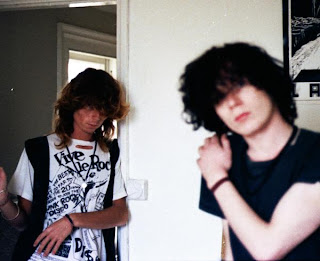.jpg) Дэйв (слева) с братом, по возвращении из Индии в 1987-м г.
Дэйв (слева) с братом, по возвращении из Индии в 1987-м г.Дэйву тогда было 22, и, по его признанию, максимум, что он ожидал увидеть на хвалёных ритуальных Гоа-вечеринках, – это укуренных и опалённых тропическим солнцем хиппи, бряцающих Боба Марли на гитарах... :)
Реальность – а точнее, сверхреальность, – в которой он очутился, вступив на заповедную территорию курируемого Лораном индийского Trance-Dance-эксперимента, оказалась куда более шокирующей, переворачивающей сознание и опережающей своё время, чем самые бесшабашные и авангардные прорывы тогдашней клубной Америки и Европы!
В гоанском кислотно-мистическом котле, абсорбирующем муз. жанры, национальности и религиозные верования, в середине 80-х уже вовсю выплавлялся и выкристаллизовывался стиль, которому будет суждено покорить танцполы Европы лишь 7-8 лет спустя под названием Trance и Psychedelic-trance!
 Cafe Ruin, Anjuna, Goa, 1987 (taken from Goa Gil's photo archive).
Cafe Ruin, Anjuna, Goa, 1987 (taken from Goa Gil's photo archive).В общем, обо всём этом (и, разумеется, о Лоране – самой таинственной и закрытой персоне в истории мировой электронно-танцевальной музыки, её "Сером кардинале" и одном из наиболее влиятельных Отцов) – ниже по тексту, слово Дэйву...
На британском авторитетном муз. ресурсе Bleep43.com, где Дэйв впервые запостил свой потрясный аудио-текстовый "Goa Piece" в середине апреля, имел место второй – спустя более 20-и лет после описываемых событий – эпизод, когда Laurent, этот суперприватный азиатский затворник, величайший из ди-джеев и кассетных шаманов современности, самолично да ещё и развёрнуто откомментировал Интернет-публикацию о себе и своей творческой деятельности в Гоа 80-х гг. [ссылка на дэйвовскую статью была передана ему Гилом, по моей просьбе]!
Unveiling the Secret – The Roots of Trance
by Dave Mothersole
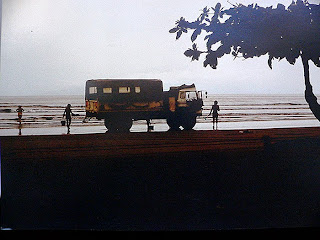.jpg) Beach in Goa and the End of the Road, 1974 (coast of Indian ocean), photo by Guruguitarman.
Beach in Goa and the End of the Road, 1974 (coast of Indian ocean), photo by Guruguitarman.So there we were, three fresh faced, south London former soul-boys in bashed up Armani jeans and Converse, huddled together on the back of a motorbike taxi, heading off to our first party.
“We’ll show these hippies what it’s all about” – I thought as the driver, perched up on the bike’s tank, deftly negotiated the pot holes and a million insects buzzed away in the warm night air.
It was late August 1986 and still monsoon time. As we grew closer I could see dozens of Royal Enfields haphazardly abandoned on the pathway that lead to the carcass of the old Catholic church where the party was being held. Groups of people were sat around outside smoking chillums. Some looked up and stared as we passed by and it began to dawn on me that this might not turn out quite as I’d expected. Nothing though, could prepare me for the shock I got as we walked inside.
It was like stepping into another world. UV pictures of blacksploitation babes and leather clad joy boys hung from the walls as the speakers pumped out these dark, synthetic beats. Wild eyed loons in flip flops and rags leapt about next to girls who looked like they had just walked in off some Milanese cat walk. An American kid in his late teens dressed in a Mickey Mouse tracksuit and sporting the best Billy Idol haircut I’d ever seen, walked up and offered us some liquid acid. “Full trip or half trip” – he leered, pulling out a whacking great needle-less syringe and gesturing at us to hold out our hands for a dose. “Could change your life” – he said with a sly chemical grin and an air of overbearing superiority. I went for half, holding out my nervously clenched fist in a mixture of curiosity and fear.
Outside Indian chi ladies from the local villages had set up little stalls selling tea and cakes and all around people were dancing like it was their last night on earth. Clouds of pungent Manali smoke filled the air as the incessant, narcotic groove chugged away like a runaway train. It was like Lord of the Flies and H.G. Wells’ Time Machine in a blender with an acid fried version of Miami Vice. A post apocalyptic Monte Carlo, reclaimed by nature and inhabited by a tribe of wild, decadent, jet set gypsies partying their way into some new collective consciousness.
Far from showing them what it was all about, we looked on in a mixture of horror, fascination and wide eyed disbelief. Passive observes who’d stumbled across this weird bacchanalian scene. In a church, at the end of a dirt track. A few thousand miles from where we from, but a million miles from anything we knew. As defining year zero moments go, this was a major one for me. I’d expected to find a few burnt out pot heads singing Bob Marley songs around a campfire. Not this. That American kid was right – life was never quite the same again.
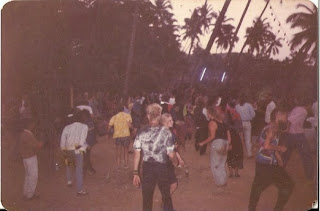 South Anjuna spot, the night, 87/88 season (photo by Inge D'anjuna).
South Anjuna spot, the night, 87/88 season (photo by Inge D'anjuna).To understand how a bunch of Western misfits, searchers, junkies and fugitives ended up dancing to a mutant strain of proto-Techno on a beach on the Arabian sea, you have to go back to the late 60’s. The story of how Goa became a magnet for freaks the world over, can be seen in the excellent Facebook documentary, Goa Hippy Tribe. Suffice to say though, by the mid 70’s, the Full Moon parties were in full swing with bands playing all night on big four way speaker stacks. Come the early 80’s, the original crowd of hedonistic settlers had been joined by a new generation, many of them European, who brought their own music with them.
It’s unclear exactly who set up the first electronic music parties in Goa – some credit a character called Dr. Bobby (father of Tiga) – but it is known that many of the new arrivals would frequent clubs in Ibiza, London, Berlin, Rimini and Riccione when they returned to Europe for the summer. It’s also clear that they had little or no attachment to the 70’s rock favoured by the original crowd.
Initially they were met with some fierce resistance, but by 1983 electronic music had pretty much taken over. And so it was that at the same time that Chicago was creating House and Detroit was forging ahead with what would become Techno, the roots of Trance were being sawn on the beaches of Anjuna and Vagator. And just as Chicago had Ron Hardy and Detroit had The Electrifying Mojo, Goa had a DJ called Laurent.
If it wasn’t for him, it’s quite possible that the music played at parties in Goa would have been little more than a carbon copy of what was going on back in Europe and America. But like all true pioneers, Laurent made it much more than the sum of it’s parts and in doing so created a whole new style of music.
 Laurent, Goa Gil, Luigui in South Anjuna, 1991 (photo from Goa Gil's archive). NB: Лоран играет с Walkman WM-D6C Pro, открыт перед ним (см. далее по тексту).
Laurent, Goa Gil, Luigui in South Anjuna, 1991 (photo from Goa Gil's archive). NB: Лоран играет с Walkman WM-D6C Pro, открыт перед ним (см. далее по тексту).Legend has it that when he left France for Goa he told his family he’d be back in a couple of months, never to return. Whether this is real or not is anyone’s guess. Goa has always has been a place that lives on rumours and half truths and separating fact from fiction has never been easy. For his part, Laurent credits fellow Frenchman Fred Disko with being the first person to play electronic music in Goa. And there were of course others like Swiss Rudi, Stefano and the now ubiquitous Gil. But it was Laurent who defined the style and set the parameters for what would become Trance.
He took all the new electronic music coming out of Europe and America, cut out most of the vocals and parts he didn’t like, extended the parts he did and stitched it all together into one long, constantly morphing psychedelic groove. New Wave, Italo-disco, EBM, New Beat, Goth, Electro, Hi-NRG, Synth-pop, House – anything was up for grabs. As long as it had the right vibe, it could be made to fit. But unlike his DJ counter parts in the West, Laurent didn’t use records – the heat and dust in Goa made that imposible – he used cassettes.
Tapes had been played at parties in Goa ever since the introduction of amplified music and by the early 80’s the Sony profesional walkman was the deck of choice. It was hard wearing, sounded good and it had a pitch control. It also had a mechanical pause button with a very precise action. This was imperative, not just for playing live, but also as a way to re-edit and re-arrange tracks. Many of the biggest hits in Goa during the 80’s were substantially re-edited, often to take out any unwanted vocals, but also to extend some of the rhythmic passages. Laurent’s re-edits of Blancmange’s “Living on the Ceiling”, Boytronic’s “Hurts” and Soft Cell’s “Sex Dwarf” are legendary examples, but many other songs had the same treatment.
.jpg) The highest quality Sony Walkman recording cassette deck – the Walkman Professional WM-D6C (introduced in 1984).
The highest quality Sony Walkman recording cassette deck – the Walkman Professional WM-D6C (introduced in 1984).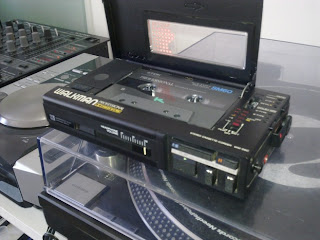 Раритетный экземпляр из коллекции самого Дэйва (Dave's own WM-D6C)!
Раритетный экземпляр из коллекции самого Дэйва (Dave's own WM-D6C)!Removing the vocals was considered important as they would often distract from the dancer’s trip. However, it did depended on what type of vocal it was. Anything that sounded pop-y was out, but more abstract subject matter, especially if delivered in a “New Wave” style voice, was allowed. So acts like Depeche Mode, Psyche and Front 242 were often played with the vocals intact, whilst Den Harrow, for example, wasn’t.
But whilst singing was often removed, newsreel and documentary style voices were used a lot. And as LSD and Manali charas were the most prevalent drugs at parties, the audiences were very susceptible to the content of these soundbites. Religion, Re-birth, The Cold War, Drugs, Time Travel, Mysticism, Nuclear Disaster and Sci-fi were all popular themes and at times it felt like these messages were being beamed down directly from space. That we were God’s chosen ones; his disco dancing, cosmic flower children; ecstatically gyrating our way, Shiva-like into new realms and understanding.
That’s probably why Laurent’s style caught on. By taking the psychedelic aspects of experimental rock and applying them to electronic dance music, he had created a sound that was both accessible and otherworldly. It was functional too, which was important because like any other DJ, his success depended on his ability to make people dance.
The demographic in Goa at that time was quite wide, with the age range going from 18-50 and the male to female ratio being fairly even. His skill was to get all these people on board whilst simultaneously pioneering a new style of music. And like all truly great DJs he was able to do this because he had the ability to make records translate. Tracks like Orient Affair’s “Classic Dance” or Hypnosis’ “Droid” may have sounded a bit camp or even pompous back in Europe, but they were given a strange poignancy as 500 people kicked up dust clouds under the coconut palms.
Messing with song tempos was another Laurent trademark and you would often hear him slowing Hi-NRG tracks down to around 100 Bpm. He really understood the importance of context. How, because of the drugs, the mind blowing locations and the tribalistic nature of Goan beach parties, he could make tracks feel and sound different.
Playing for anything up to 10 hours at a time he would move from dark, hard hypnotic beats during the night, to sweet, uplifting, sun kissed grooves in the morning. From Skinny Puppy and Nitzer Ebb to Koto and Laser Dance; from 100 to 150 Bpm; from nightmare-ish and scary to blissed out and glorious. It was a heady combination and one that had a tremendous impact on the lives of many.
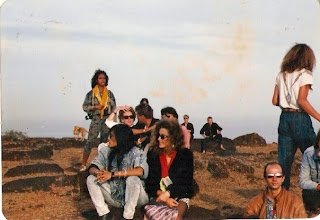 Goa party people '89/90 (photo by Inge D'anjuna).
Goa party people '89/90 (photo by Inge D'anjuna).After that first party I stayed in Anjuna for a few months as the season picked up, before travelling around India. I went back to Goa the following year and fully immersed myself in the freak lifestyle. It was a wonderful time and I was lucky enough to be a part of some truly amazing parties. When I got back, Acid House had started to happen in England, so I got involved in that and gradually lost touch with the Goa scene.
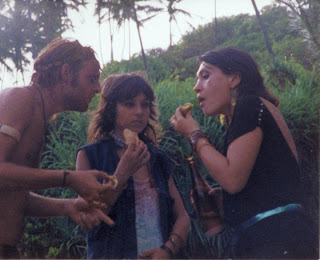.jpg) Party scene, Vagator beach, 1982 (photo by Krishna Beutel).
Party scene, Vagator beach, 1982 (photo by Krishna Beutel).I’m not fan of what Trance became. As soon as people started calling it "Psy-Trance" and making music with Goa in mind, it lost its way for me. That’s fine though. I’m not a fan of what Punk became either – but that doesn’t stop The Clash being my favourite band. Just because Trance became a narrow, soulless succession of drug triggers, that doesn’t take anything away from what Laurent did back in the 80’s and early 90’s. His legacy goes beyond way beyond such limitations.
Apparently he’s stil living in Goa, doing his thing, shunning the limelight and occasionally turning down interviews with visiting journalists.
The real father of Trance. A true legend.
A selection of the acts played by Laurent and others in Goa from 1983 – 89:
Acts of Madmen, Alien Sex Fiend, A Split-Second, Anne Clark, Android, Arthur Baker, Art of Noise, BAD, Bappi Lahiri, Blancmange, Borghesia, Boytronic, Cabaret Voltaire, Carlos Peron, Cassandra Complex, C.C.C.P., Chris & Cosey, Code 61, Cyber People, DAF, Decadance, Den Harrow, Depeche Mode, Devine, Dr. Calculus, Ecstacy Club, Egyptian Lover, Electra, Fad Gadget, Fatal Attraction, Force Legato, Front Line Assembly, Front 242, FockeWulf 190, Giorgio Moroder, Hard Corps, Hashim, House Master Boys, Hypnosis, Icarus, Information Society, Ironic Remark, I Start Counting, James Ray and The Performance, Jellybean Benitez, Jean-Michel Jarre, John Carpenter, Karen Finley, Keith Leblanc, Koto, The KLF, Kraftwerk, Krush, Lama, Laser Cowboys, Laser Dance, Liaisons Dangereuses, Man Parish, Manufacture, Mark Imperial, Mark Shreeve, Ministry, Mittageisen, Moev, Morton Sherman Bellucci, Moskwa TV, Neon, Neon Judgement, New Beat Express, New Order, Newcleus, Nitzer Ebb, N.O.I.A., Nux Nemo, Off, Orient Afair, Peter Richard, Poesie Noire, Portion Control, Public Relations, Psyche, Richard H. Kirk, Robotiko Rejekto, Sandy Marton, Severed Heads, Screaming Trees, Signal Aout 42, Simple Minds, Sisterhood, Skinny Puppy, Space Opera, Spectrum, Soft Cell, Syntech, Tackhead, Tangerine Dream, Tantra, Telex, The Maxx, Time Zone, Torsten Fenslau, Total, Tribantura, Two of China, Vicious Pink, Voyou, Yello, Zwischenfall, 400 Blows, 4You, 16 Bit...
ॐ Aum Namo Narayan! ॐ

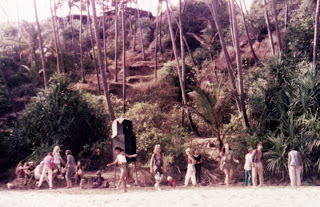
.jpg)
